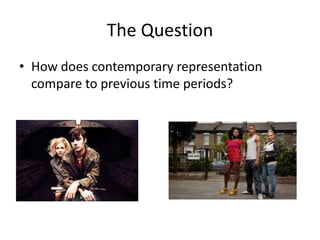Collective prompt 2
- 1. Collective Identity Prompt Question two
- 2. The Question • How does contemporary representation compare to previous time periods?
- 3. Translation • Compare how contemporary media construct (represent) British Youth as opposed to how historical media texts constructs British Youth.
- 4. Examples • Compare how British Youth are represented through film texts and TV in contemporary media text and historical media texts. • Why were young people represented in a particular way? Has it changed or stayed the same?
- 5. 1930s- • Teen as a collective group was not established • Example TV programme associated with representing young people where limited- • one example is Good Manners- • Constructed a positive representation of young people. • Well spoken, well mannered, very polite when addressing each other and their tone is overall very calm.
- 6. 1950s- • Rock n Roll Culture- • Approach taken by young people: Not trying to ‘fit’ into adult mainstream- happy to rebel against it- • first indication of a ‘generation gap’- • change in values and lifestyles- • Example film 1954 The Belles of St Trinian’s– • Negative representation – • synopsis- A new term opens at St Trinian's School for Young Ladies, striking terror into the local residents and police.
- 7. 1960s-70s- • sub culture to counterculture- Mods and Rockers In Britain • Example film Quadrophenia (1979)- representation of the sub cultures • ‘Quadrophenia‘ theModsand rockers are represented in traditional clothing so as to be instantly recognisable and shown engaged typically getting into fights in 1960s Brighton, often involving innocent bystanders. • A mode of behavior roundly condemned by hegemonic opinion leaders (press reports) ‘perfectly capturing the teenage need to belong and identify with their peers.‘
- 8. 1960s-70s • In 1961 the war in Vietnam started, it lasted almost 10 years and ended in 1970. • During that time the Hippie movement first appeared. • This movement was very peaceful. • In general these people were against the war. • Associated aspects- drugs, peace, rock, Peace and Love and Long hair.
- 9. 1970s • Between 1974-1976 Punk Culture within young people- aesthetic and political rebellion. • TV Programme- Hippie and Punk Cultures represented in The Young Ones produced in the1980s.- • The main characters were four undergraduate students sharing a house: violentpunkVyvyan, pompous would- be anarchist Rick, long-suffering hippie Neil, and the smooth and diminutive Mike. • ‘Representation of the young generation as upbeat, exciting and refreshingly fun’ Bill Osgerby
- 10. Hebidge • Hebidge studied British youth subcultures in the late 1970s. • youth subcultures are a way for young people to express their opposition to society, and to challenge hegemony. This is primarily expressed through style. • Representations of young people are quite limited showing them as either fun or trouble. Again this suggests media representations of young people do not really relate to reality.
- 11. Today- • Gang Culture/ • Gangster Culture/ • ChavCulture/ • Drinking Culture/ • Sexualisation of young females.
- 12. Overall • It is evident that negative representations of young people in TV and Film is not a new construction. • The change in representation could be argued to relate to the specific sub cultures of the time period. E.g. Mod and Rockers and the representation of Youth in Quadrophenia.











